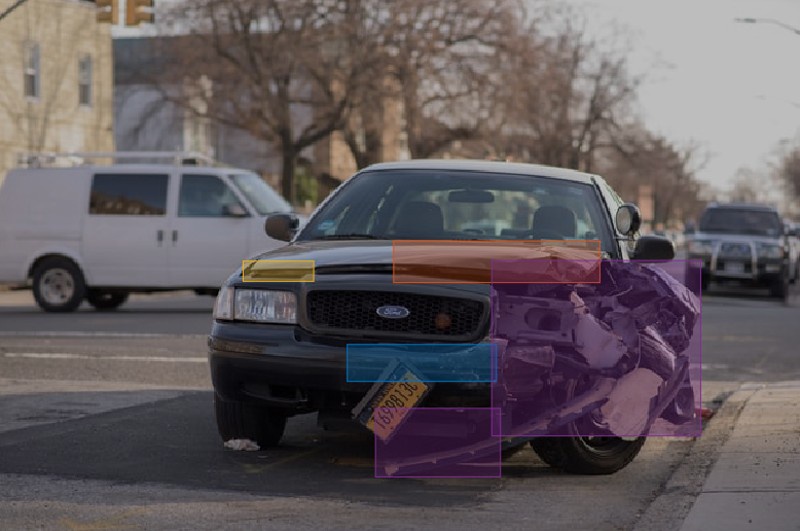Machine learning is already being employed across multiple industries to automate the processes that are slowed down by manual, repetitive steps. With advanced algorithms, techniques, and frameworks under the hood, AI tools can accelerate the process of recognizing damaged vehicle parts, assessing damage, making predictions about what kind of repair is needed, and estimating how much it may cost.
Computer Vision for Vehicle Damage Assessment
Computer vision, a technology that processes visual information and interprets data, can paint a fuller and more accurate picture of an auto accident, including the conditions, scene, and what repairs are needed.
When imagery is available, captured through cameras onboard vehicles or via street surveillance, computer vision technology can extract, analyze, and provide insights to aid and speed up the inspection process, benefiting both insurers and the insured. It can determine who is at fault based on precise measurement analysis, road, and traffic conditions. So drivers who aren’t at fault can breathe a sigh of relief.
Applying computer vision to vehicle imagery can also help assess damage post-accident. Algorithms trained on volumes of estimate data and photos can determine whether a car is repairable or a total loss and list the parts damaged and to what degree, speeding up the repairs process and reducing the inconvenience for insureds. Soon this capability will be able to generate an initial estimate to further expedite the claims process. Imagine how revolutionary this will be for drivers in accidents. Even before they return home or to the office, their insurer will have been alerted to the loss, approved the initial repair estimate, and booked it into the local auto repair center.
In the claims process, imagery using computer vision both before and during the accident provides tremendous visual data to analyze the weather, lighting, scene, speed, and traffic. These visuals contain many of the facts required to determine liability and feed into the adjudication of other issues, such as subrogation and injuries. In addition, computer vision also can help quickly decide the inspection path a vehicle should enter, and whether the claims process requires staff or third-party resources. Using technology to solve issues previously requiring someone else’s eyes also helps lower loss adjusting expense.
Data for Vehicle Damage Assessment
While building a solution capable of addressing the enlisted needs, developers need structured Training Data.
1. Finding a proper dataset
Training machine learning models requires a sufficient data set of relevant images. The more varied the images are, the better the model will be able to classify images appropriately. In the context of car damage assessment, obtaining a substantial amount of images is a challenge, since there is no public database for images depicting damaged vehicles. While it may be possible to come up with a raw data set through web scraping, working with car insurance companies that already have numerous images of broken car parts, may also be a feasible option.
So, a company needs to evaluate the most optimal way in terms of ROI or time by deciding whether to buy the data set, get it from an industry partner, or build/collect it from scratch. They can also outsource the task of data Collection to third-party vendors like TagX who specialize in Data operations for AI model training. Even having obtained a collection of images, one should ensure the pictures satisfy the demands for size, quality, etc.
2. Preprocessing
Preprocessing image data sets is a crucial step in speeding up and obtaining better training results for models. This activity may span a variety of tasks: applying filters, removing noise, enhancing contrast, downsampling images, etc. With proper preprocessing, photos that are too blurry, too dark, or too bright can also be utilized. This way, photos, where a car is not initially detected or looks ambiguous, can be adjusted to work.
For instance, this can be done with OpenCV, one of the most used machine learning libraries for image preprocessing. It has over 2,500 optimized algorithms for identifying objects and putting pictures together to create a high-resolution image of an entire scene.
3. Data Annotation
In order for this technology to fully realize its potential insurance AI developers need to feed their machine learning algorithms with accurate annotated data. These systems will be required to identify and analyze objects and scenarios in endlessly complex real-world environments. Creating training datasets that reflect this complexity can be overwhelming for many companies, causing lead researchers to lose focus on their core goals.
Using professional annotation services can provide insurance AI innovators with a variety of distinct benefits. Professional annotation services, such as TagX, rely on their teams of annotators to ensure that datasets are of high quality. Annotation work can be handled by experienced managers, which relieves AI businesses of this load.
The way forward
Insurers need to reimagine their systems, operations, and partnerships to successfully adopt computer vision. It will involve collecting and processing vast amounts of data. Carriers must have the right systems to capture inspections data in the form of pictures, videos, and annotations, and the security in place to safely store, access, and share data among key stakeholders.
By working with partners to access AI, data engineering, and other digital tools, insurers can take advantage of these new technologies as they come to market without waiting for them to become fully plug-and-play. They need to ensure that their claims processes augment new technologies and decide who is going to execute the outcomes.


No comments yet